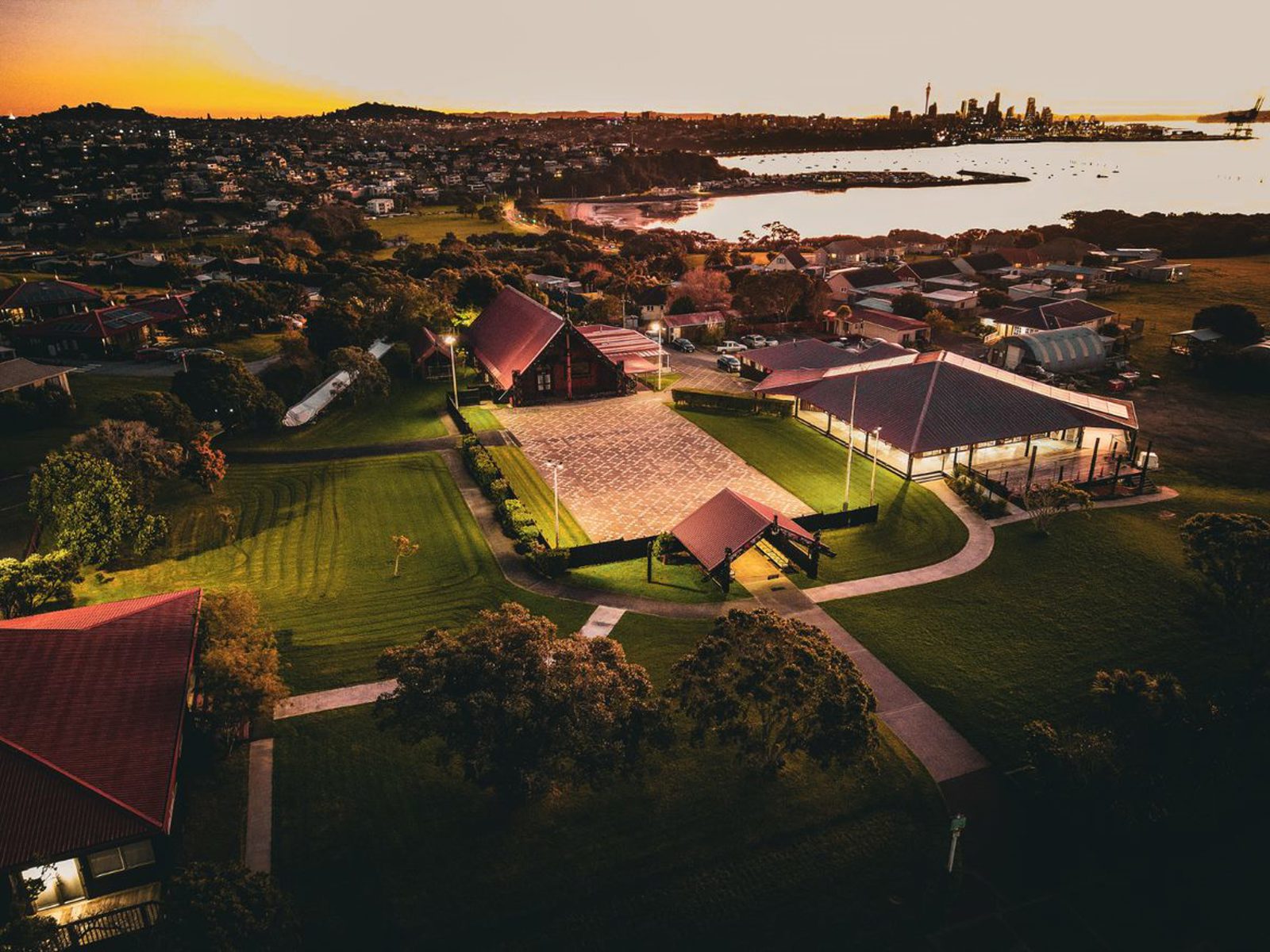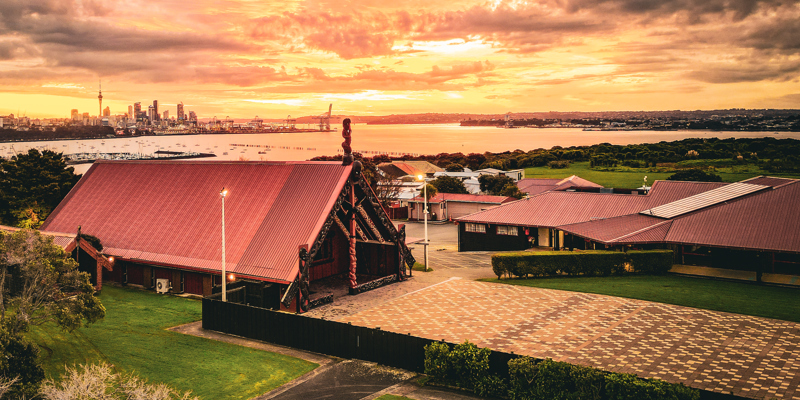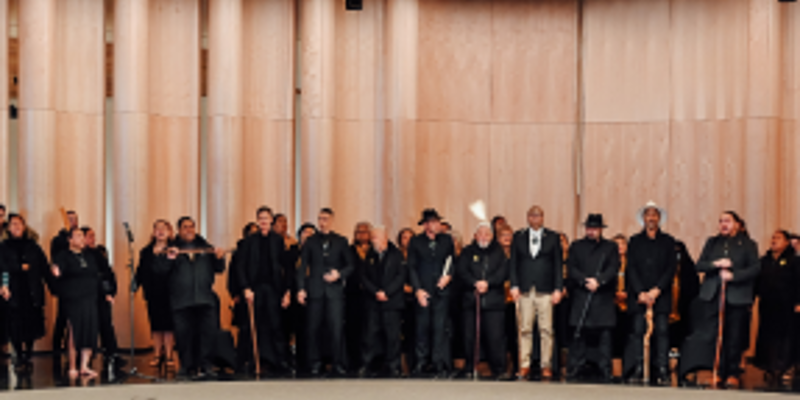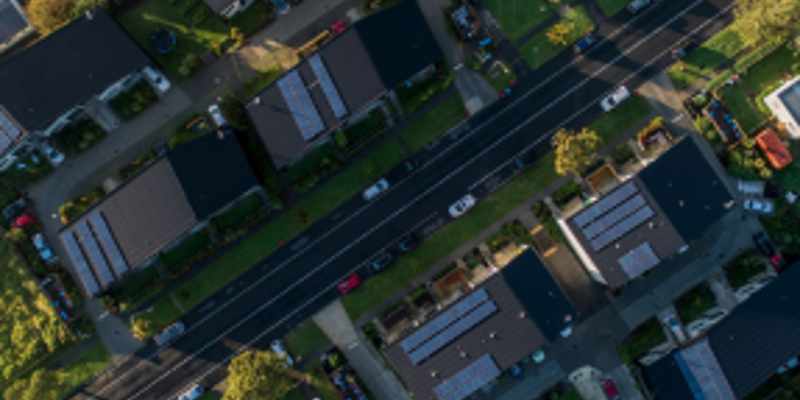Ngā Kōrero mō Ōrākei Marae
The Establishment of Ōrākei MaraeTe Hītori
I te tau 1954, i whakatahangia e Te Kāwanatanga he kotahi eka i te hiwi e kīia ana ko Te Paepae a Te Kawau hei wāhi motuhake mā ngā kaupapa Māori. Waihoki, i whakatūria tētahi komiti whakahaere mō taua whenua, heoi ko te nuinga o ngā mema rā nō iwi kē. Kāore a Ngāti Whātua i whakaae ki taua komiti.
Ahakoa tērā, i tū te whare tuatahi ko Te Puawai i te tau 1964 hei wāhi whakaako tamariki (Waitangi Tribunal, 1987). I muri mai, ka whakatūngia ētahi tāwharau hei whakamarumaru i ngā mahi. I te tau 1973 i kawea mai he oneone i Ōkahumatamomoe e Tame Tauna rāua ko Eruera Stirling nō Te Whānau-a-Apanui (Salmond, 1980) ki Te Paepae a Te Kawau. Nā konā i tapu ai te whenua hei wāhi tū mō te wharenui hou.

I whakaingoatia a Henare Toka o Ngāti Whatua hei tōhunga whakairo heoi kīhai i roa, ka mate ia. Nō muri ka hui tahi ngā kaumātua, ā, ka tahuri atu ki tētahi Pākehā ki a Denis Conway, me te aha, ko ia te pura tuawhiti o ngā tauira a Henare Toka. Ko Murray Pihema, rātou ko Len Phillips, ko Ben Tumahai, ko Harry Wikaira, ētahi o ngā kaiwhakairo i tārai i ngā peka a Tāne. Ko Maude Tumahai rātou ko Alice Pihema, ko Piupiu Hawke, ko Makareta Tamariki ētahi o ngā wāhine i ako ai i ngā mahi raranga i te timatanga o te kaupapa. Heoi, ka huri ngā tau ka tīmata ētahi atu ki te whai atu i ngā tapuwae o ērā kuia.
I te tau 1975 i whakatū ai te komiti i tētahi wharekai hou hei wāhi mahi moni, hei wāhi whakangahau i ngā pūkoro nui o Tāmaki. Ka tutū i a Ngāti Whātua te puehu nā te mea ka hiahia rātou ki taua wharekai hei whare manaaki i ngā manuhiri. I tētahi hui o te Taraipiunara o te Tiriti o Waitangi, i puta ai te wero a Hapi Pihema nō Ngāti Whātua. Hei tāna, “ko wai ēnei tāngata e pīkoko nei ki te mana whakahaere o tōku marae? He aha tō rātou hononga ki ēnei whenua, ki ēnei tāngata?” (Waitangi Tribunal, 1987). I te tau 1987, i puta ai tētahi whakataunga nui a te Taraipiunara o Te Tiriti o Waitangi, mā Ngāti Whātua tōna marae e hautū. Kātahi ka riro i te Poari o Ngāti Whātua Orākei te mana whakahaere.
Ahakoa ngā piki me ngā heke, i te tau 1989 i oti te wharenui. Ka tūwhera ai hei whakapiringa mō te tangata hei whakairinga mō te kōrero. Ka tapaina te whare ki te ingoa a Tumutumuwhenua, tētahi tupuna nui i roto i ngā whakapapa o te Tai Tokerau. Hei tā Grant Pakihana Hawke, ko te mea nui i tērā wā, kua tū rangatira anō a Ngāti Whātua (personal communication, May 25, 2014).
I te tau 1990, ka toro te whare i te ahi. Ka tau mai tētahi pouri nui ki te iwi me te mōhio he pierenuku te mahi whakahou whare. Heoi, nā runga i te akiaki a Sir Hugh Kāwharu me te tautoko a ngā kaumātua me ngā kuia, i tīmata ai ngā mahi whakahou, ā, ka oti i te tau 2006. Nā Hone Kōmene rāua ko Takutai Wīkiriwhi ngā karakia i takitaki kia oho anō ai te mauri o te whare. I te tau 2001, i oti hoki te wharekai hou ko Te Puru o Tāmaki hei manaaki i ngā manuhiri ka tae mai.

In 1954, one acre was set aside by the Government on the ridge called Te Paepae a Te Kawau for Māori purposes. A committee was established to manage the land and it’s activities however most members were from other tribes. Ngāti Whātua did not agree with the makeup of that committee.
Even so, Te Puawai was the first whare to be erected in 1964 as a place for educating young Ngāti Whātua minds. Later, sheds were erected to host a range of activities including funerals. In 1973, soil from the Ōkahu village was carried by Tom Downs and Eruera Stirling to Te Paepae a Te Kawau. Hence the land was set aside as the site for a new carved meeting house. Henare Toka of Ngāti Whātua was named as the expert carver to lead the project but sadly passed away not long after.
The elders then turned to Australian Denis Conway who was a top student of Henare Toka. He agreed. Murray Pihema, Len Phillips, Ben Tumahai, Harry Wikaira and many others were the carvers who were gathered to finish the carvings. Maude Tumahai, Alice Pihema, Piupiu Hawke and Makareta Tamariki were some of the women who learnt weaving at the beginning of the project. As the years went by, others followed in the footsteps of those kuia.
In 1975 the committee erected a new dining room for fundraising and entertaining the wealthy. Ngāti Whātua were very displeased as they wanted a place to host their visitors. At a Waitangi Tribunal hearing, Hapi Pihema of Ngāti Whātua challenged; Who were these people who coveted the leadership of my marae? What was their connection to the land and people? A major recommendation of the Waitangi Tribunal was that Ngāti Whātua must manage and lead its own marae. Soon afterwards the ownership and control of the marae was vested in the Ngāti Whātua Orākei Trust Board. Although the ups and downs, in 1989 the carved house was completed and was opened as a place of gathering for the people and repository of tribal stories.
The house was bestowed with the name Tumutumuwhenua, a well-known ancestor from the north. According to Grant Pakihana Hawke, the main thing during that time was that the mana of Ngāti Whātua’s was reclaimed. In 1990 the house was damaged by fire. A deep sadness descended upon the people with the knowledge that a rebuild would be difficult. However, upon the call of Sir Hugh Kāwharu and the tribal elders, the refurbishment soon began and was finished in 2006. Hone Kōmene and Takutai Wīkiriwhi led the customary rituals to reawaken the life-force of the house. In 2001 the new dining room Te Puru o Tāmaki was also completed to host the visitors of Ngāti Whātua.
Important Documented Timeline of Events
Related to Tumutumuwhenua1959
-
The government designates a site and later builds a national marae for Ngā Hau e Whā (people of the four winds) on Ngāti Whātua Ōrākei ancestral lands. This is a gross insult to their mana.
1963
-
A new chapel is opened. Piki, the daughter of Korokī, is given the key and her people perform the opening ceremony. Soil from the site of the old wharenui, Te Puru o Tāmaki, is blessed in the new church. The soil is then scattered on land designated for a new marae and where the new wharenui will stand. This symbolises continuity between the former and the new wharenui.
1971
- Work begins on the new wharenui.
1972
-
The New Zealand Forest Service provides 2000 cubic feet of tōtara from the Whirinaki forest, of Ngāti Whare for carvings.
1976
- An administration building opens.
1990
- The wharenui is gutted by fire. It is refitted and redecorated with tukutuku and kōwhaiwhai designs. The carvings are sandblasted and reinstalled in the wharenui.
Learn more about us
-

Ōrākei Marae
Steeped in history and surround by spectacular views over looking the Waitemata Harbor, Ōrākei Marae is the cultural hub for the people of Ngāti Whātua Ōrākei. Ko Tumutumuwhenua te whare tūpuna. Ko Te Puru o Tāmaki te wharekai. Ko Ōrākei te marae. -

NWO Trust
The purpose of the Trust is to receive, administer, manage, protect and govern the Trust’s assets to ensure the cultural, commercial and social development of Ngāti Whātua Ōrākei for the benefit of it's members. -

Whai Māia
Whai Māia is established as a charitable entity responsible for the social and cultural development of our people. With a focus on whānau outcomes and managing a large number of programmes covering areas such as health, education, small business and employment. -

Whai Rawa
Whai Rawa is the commercial investment company of the Ngāti Whātua Ōrākei group responsible for protecting and growing our commercial assets.